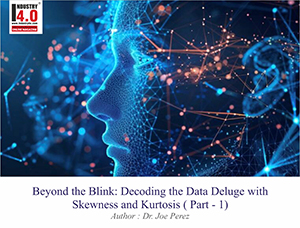Beyond the Blink: Decoding the Data Deluge with Skewness and Kurtosis
( Part – 2 )
Beyond the Blink: Decoding the Data Deluge with Skewness and Kurtosis ( Part – 1 )
 Part Two : Handling Kurtosis in Data Analysis: Managing Outliers and Variability
Part Two : Handling Kurtosis in Data Analysis: Managing Outliers and Variability
We’ve explored skewness and how it reveals the imbalance in a data distribution. Now, let’s turn our attention to kurtosis, the other key player in our data analysis toolkit. While skewness focuses on the tilt or asymmetry of the distribution, kurtosis goes beyond that. It quantifies the extent of the tails in a data distribution, revealing the likelihood of outliers – those extreme boxes in our warehouse that are much larger or smaller than the others.
There are two main types of kurtosis:
High Kurtosis: Imagine a data distribution with pointy, elongated tails, resembling a warehouse with a significant number of boxes stacked very high or very low, with a smaller concentration of boxes around the middle height. This scenario represents high kurtosis, indicating a higher probability of outliers in your data. High kurtosis can greatly impact how we interpret the data, potentially leading to misleading conclusions. For instance, high kurtosis in social media sentiment analysis, where you’re analyzing the tone of tweets about a new product launch, could suggest a large number of both extremely positive and negative reactions.
Low Kurtosis: On the other hand, low kurtosis depicts a data distribution with flat tails, like a warehouse where most boxes are clustered around a similar height with very few outliers stacked extremely high or low. This suggests a lack of extreme values, potentially signaling a distribution overly focused around the average.
Let’s examine some examples to understand the practical implications of both high and low kurtosis in data analysis.
Example: Understanding Customer Sentiment on Social Media
Imagine analyzing the sentiment of tweets about a new product launch. If you encounter high kurtosis, it suggests a higher probability of both extremely positive (“This product is amazing!”) and negative (“This product is a total flop!”) reactions. This information is crucial for brand strategists, as it signals potential areas for improvement (like addressing negative feedback) or highlights unexpected customer enthusiasm that can be leveraged in marketing campaigns.
Dealing with High Kurtosis
To address high kurtosis and ensure reliable analysis, we can employ a few strategies:
Robust Statistical Methods: Imagine using tools specifically designed to work effectively even with outliers in the warehouse. These robust methods, like using the median (the middle value) instead of the mean (the average) to represent the center of the data, can help mitigate the influence of outliers on the analysis.
Data Transformation: Another approach is to transform the data, like applying logarithmic or square root transformations. This technique essentially compresses the tails of the distribution, making the data resemble a warehouse with fewer extreme stacks and a more even distribution of boxes around a central height. In the case of social media sentiment analysis, applying a square root transformation can stabilize the variance of sentiment scores and lessen the impact of extreme positive or negative outliers. This transformation makes the data more suitable for further analysis, such as identifying emerging trends in customer sentiment.
Identifying and Managing Outliers:Outliers, those extreme data points, can sometimes be hidden gems. Imagine exceptionally positive reviews uncovering strengths the product development team might have overlooked. To address these outliers, we can use a technique called “winsorizing.” Think of it like adjusting the heights of the extremely tall stacks in our warehouse to a certain limit, rather than flattening them entirely. Winsorizing retains the valuable information within the outliers while preventing them from skewing the overall analysis. For the technical reader, winsorizing essentially replaces extreme values with values from the tails of the distribution (closer to the median) but not necessarily at the very ends.
Example: Unveiling Patterns in Weather Data
When examining historical temperature records, detecting high kurtosis could signal sporadic yet substantial deviations from the average temperature. This may suggest the presence of extreme weather events, like heat waves or cold snaps, that require further investigation. Utilizing statistical methods that account for outliers, like robust regression, can help create more accurate climate models. These models can better predict future weather patterns and improve preparedness for extreme weather events.
We’ve discussed high kurtosis, but what about low kurtosis?
Low Kurtosis and Its Implications
While high kurtosis often attracts attention due to the presence of outliers, low kurtosis also deserves consideration. A data distribution with low kurtosis indicates a lack of extreme values, resembling a warehouse where most boxes are stacked around a similar height with very few outliers. This can pose challenges in situations where variability is crucial.
For instance, in a company’s sales data, low kurtosis may indicate a lack of significant sales fluctuations. This could suggest a scenario where sales figures hover around a consistent average, with neither substantial growth periods nor significant dips. This information might prompt the company to explore new marketing strategies to introduce more variability and potentially boost sales figures. Perhaps the company could consider launching targeted campaigns or introducing new product lines to stimulate customer interest and encourage sales growth.
Addressing Low kurtosis
To tackle low kurtosis, it may be necessary to review your data collection methods to ensure they can effectively capture variability. Imagine re-evaluating how you organize the boxes in your warehouse to better reflect the data you’re collecting.
For instance, incorporating open-ended survey questions alongside multiple-choice options could yield a wider range of responses, offering a more precise depiction of customer preferences. This would result in a data distribution with a wider spread, potentially reducing low kurtosis. By refining data collection methods to capture a broader range of values, you can obtain a more comprehensive picture of the information you’re analyzing.
The Importance of Context: Beyond the Numbers
Albert Einstein has been quoted as saying, “Not everything that can be counted counts, and not everything that counts can be counted.” This quote perfectly encapsulates the importance of understanding both the numerical measures like skewness and kurtosis, and the broader context of the data. While statistical analysis provides valuable insights, it’s crucial to remember that data is a representation of reality, not reality itself.
For instance, a high average house price might not be particularly meaningful if most of the houses are clustered towards the lower end of the price range. Similarly, a low average customer satisfaction rating might be misleading if it’s based on a small sample size or doesn’t account for the specific product or service being reviewed. By considering these nuances, data analysts can draw more meaningful conclusions from their analyses.
Conclusion – Understanding Data’s Essence Through Skewness and Kurtosis
Throughout this exploration, we’ve examined the intricacies of skewness and kurtosis, unveiling their influence on the interpretation and analysis of our data. But what does it all mean in the grand scheme of data science?
Data analysis relies on a symphony of statistical techniques, and skewness and kurtosis act as vital conductors, guiding us in interpreting the nuances and variability within our datasets. Just as a skilled conductor recognizes the strengths and weaknesses of each instrument section, data analysts who understand skewness and kurtosis can create more accurate and insightful models.
By addressing skewness, we ensure a balanced representation of the data, preventing outliers or extreme values from skewing the overall picture. Imagine a perfectly conducted orchestra where each instrument plays its part in harmony, contributing to the beauty of the music. Similarly, addressing skewness ensures all the data points contribute meaningfully to the analysis, preventing outliers from drowning out the quieter but potentially important information.
In much the same way, managing kurtosis allows us to account for the data’s natural variability, preventing overly simplistic interpretations that fail to capture the true complexity of the information. A skilled conductor can adjust the tempo or volume of different sections to create a dynamic and engaging performance. Likewise, managing kurtosis allows data analysts to accommodate the natural fluctuations within the data, revealing hidden patterns and trends that might be missed in a flat, unchanging distribution.
The ability to navigate skewness and kurtosis empowers us to unlock the true potential of our data. In the ever-growing field of data science, this translates to more precise financial forecasting models, more effective marketing campaigns, and even advancements in medical research. By considering these data conductors, we can transform seemingly chaotic sets of numbers into a symphony of insights, propelling us forward in an age driven by information.
The Future of Data and Its Essence
Remember the marvel we encountered at the beginning of this journey? The tiny chip, a technological masterpiece, capable of transmitting the entire internet’s traffic every second. This awe-inspiring feat speaks volumes about the ever-growing volume and complexity of data we generate. As information continues to explode, our ability to analyze it effectively becomes more critical than ever.
Skewness and kurtosis, once esoteric statistical concepts, are now essential tools in our analytical toolbox. By understanding these data conductors, we can navigate the intricacies of our information age, transforming the cacophony of big data into a harmonious symphony of knowledge. This symphony holds the key to unlocking solutions for some of humanity’s most pressing challenges – from developing personalized medical treatments to optimizing traffic flow in our ever-growing cities.
The future belongs to those who can wield the power of data. By mastering the language of skewness and kurtosis, we become the conductors of this symphony, shaping a future driven by informed decision-making and groundbreaking discoveries. It is our responsibility to unveil the essence of data, to understand its nuances, and to harness its potential for the betterment of humanity.
“Bringing Data to Life and Life to Data”

Dr. Joe Perez,
Team Lead / Senior Systems Specialist,
NC Department of Health and Human Services
Dr. Joe Perez ( Dr.Joe ) is also the Chief Technology Officer – CogniMind
To book Dr. Joe Perez for your speaking engagement please click here
Dr. Joe Perez was selected as the 2023 Gartner Peer Community Ambassador of the Year.
Dr. Joe Perez is a truly exceptional professional who has left an indelible mark on the IT, health and human services, and higher education sectors. His journey began in the field of education, where he laid the foundation for his career. With advanced degrees in education and a doctorate that included a double minor in computers and theology, Joe embarked on a path that ultimately led him to the dynamic world of data-driven Information Technology.
In the early 1990s, he transitioned into IT, starting as a Computer Consultant at NC State University. Over the years, his dedication and expertise led to a series of well-deserved promotions, culminating in his role as Business Intelligence Specialist that capped his 25 successful years at NC State. Not one to rest on his laurels, Dr. Perez embarked on a new challenge in the fall of 2017, when he was recruited to take on the role of Senior Business Analyst at the NC Department of Health & Human Services (DHHS). His impressive journey continued with promotions to Senior Systems Analyst and Team Leader, showcasing his versatility and leadership capabilities.
In addition to his full-time responsibilities at DHHS, Joe assumed the role of fractional Chief Technology Officer at a North Carolina corporation in October 2020. A top-ranked published author with over 18,000 followers on LinkedIn and numerous professional certifications, he is a highly sought-after international keynote speaker, a recognized expert in data analytics and visualization, and a specialist in efficiency and process improvement.
Dr. Perez’s contributions have not gone unnoticed. He is a recipient of the IOT Industry Insights 2021 Thought Leader of the Year award and has been acknowledged as a LinkedIn Top Voice in multiple topics. He holds memberships in prestigious Thought Leader communities at Gartner, Coruzant Technologies, DataManagementU, Engatica, the Global AI Hub, and Thinkers360 (where he achieved overall Top 20 Thought Leader 2023 ranking in both Analytics and Big Data). His reach extends to more than twenty countries worldwide, where he impacts thousands through his speaking engagements.
Beyond his professional achievements, Joe’s passion for teaching remains undiminished. Whether as a speaker, workshop facilitator, podcast guest, conference emcee, or team leader, he continually inspires individuals to strive for excellence. He treasures his time with his family and is a gifted musician, singer, pianist, and composer. Joe also dedicates his skills as a speaker, interpreter, and music director to his church’s Hispanic ministry. He manages the publication of a widely recognized monthly military newsletter, The Patriot News, and is deeply committed to his community.
To maintain a balanced life, Perez is a regular at the gym, and he finds relaxation in watching Star Trek reruns. He lives by the philosophy that innovation is the key to progress, and he approaches each day with boundless energy and an unwavering commitment to excellence. His journey is a testament to the remarkable achievements of a truly exceptional individual.
Dr. Joe Perez is Accorded with the following Honors & Awards :
https://www.linkedin.com/in/jw
Dr. Joe Perez is Bestowed with the following Licences,Certifications & Badge:
https://www.linkedin.com/in/jw
https://www.thinkers360.com/tl
Dr.Joe Perez is Voluentering in the following International Industry Associations & Institutions :
https://www.linkedin.com/in/jw
Dr.Joe Perez can be contacted at :
E-mail | LinkedIn | Web | Sessionize | FaceBook | Twitter | YouTube
Also read Dr.Joe Perez‘s earlier articles:

























